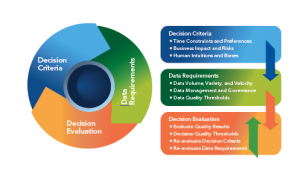Business analytics is about dramatically improving the way an organization makes decisions, conducts business and successfully competes in the marketplace. At the heart of business analytics is data. Historically, the philosophy of many insurers has been on collecting data, data and more data. However, even with all this data, many insurance carriers are struggling to achieve better analytics and gain business insight simply because many insurers’ systems typically aren’t designed to master the data in such a way to make it useful for analytical purposes.
The best way to maximize the efficiency and effectiveness of data-driven decision making is to focus on determining the sufficient amount and quality of data necessary for satisfying the execution of a business decision. Of course, this decision-making strategy is easier in theory than it is in practice.
Data driven decision management comprises three components:
- Data requirements - Different decisions will have different data requirements, which include the data volume, variety and velocity necessary for data-driven decision making. Not every decision requires the same amount and quality of data.
- Decision criteria - For example, a decision that must be made within 30 seconds has very different data requirements than a decision that should be made within 30 minutes, or a decision that could be made within 30 days.
- Decision evaluation - The quality of a decision is determined by the business results it produces, not the person who made the decision, the quality of the data used to support the decision, or even the decision-making technique.
The big data movement has brought with it a host of new technologies and analytical capabilities. However, these technologies are ineffective without the right questions and talent to create a data-driven culture.
Imagine…What if you could . . .
. . . predict the buying behavior and decision criteria of your customers and prospects weeks before your competition
. . . gain market share by storing and analyzing the explosion of telematics data for improved risk assessment and distinct competitive advantage
. . . price more accurately based on risk attributes, key demographics, competitors rates, demand elasticity models and make adjustments in real-time
It is possible.
To learn how to turn this theory into reality, download the white paper “Return on Information: The new ROI.”
I’m Stuart Rose, Global Insurance Marketing Director at SAS. For further discussions, connect with me on LinkedIn and Twitter.

